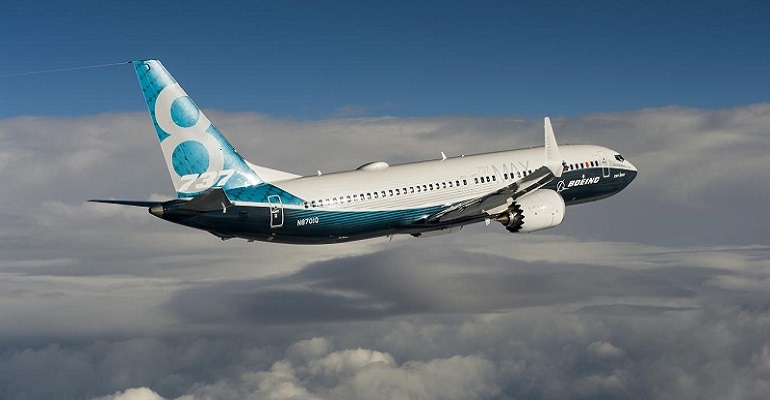Could Cloud-Based Tech Have Saved Boeing's 737 Max?
The sharing capabilities of cloud-based technologies might have made a significant difference in the development of software for Boeing’s 737 Max.
October 27, 2020

A software failure caused catastrophic problems with Boeing’s 737 Max. Boeing is currently working to solve the issue. Dijam Panigrahi, co-founder of Grid Raster, believes the problem could have been avoided if Boeing had better design-knowledge sharing through cloud-based technologies. “These technologies can help to prevent disastrous manufacturing scenarios such as the one faced by the Boeing 737 Max,” Panigrahi told Design News.
He believes that leveraging cloud-based AR/VR technologies during the design process can help design engineers avoid serious problems in product development. “On-premise design technologies do not allow for proper cross-organizational info sharing, and this is critical in large-scale buildouts such as airplanes,” said Panigrahi. “Cloud technology enables greater information sharing since designers outside the organization can research critical safety elements in other buildouts.”
We asked Panigrahi to explain this idea in greater detail.
DN: Explain this concept: On-premise design technologies do not allow for proper cross-organizational info sharing, and this is critical in large-scale build-outs such as airplanes.
Dijam Panigrahi: Usually large built-outs are a result of coming together of a large number of complex functional units and components. For example, airplanes are built to withstand extreme conditions and it's as good as its weakest component. Any slight mistake in any aspect comes with costly safety risks. Hence, complex and highly technical processes are put in place to ensure any mistake is avoided at all costs. It really takes experts on each functional unit or component to ensure everything works well as a module and also as a system. It is very unlikely that the experts are at the same place. Usually, they are spread out geographically. The current on-premise design technologies fail to take advantage of remote experts as they are very limiting proper info sharing across the organization.

DN: Explain this concept: Cloud technology enables greater information sharing since designers outside the organization can research critical safety elements in other buildouts.
Dijam Panigrahi: This limitation can be overcome by leveraging the power of cloud computing. A cloud-based approach to the design of such large buildouts comes with immense benefits. Firstly, it provides a centralized repository of all the data and information that can be accessed across geographically different locations ensuring data currency. Secondly, this allows organizations to effectively use the know-how of experts across locations and get a diverse perspective, ensuring any fault is corrected early in the process. Also, organizations can take advantage of outside expertise such as a vendor, consultant, and others, if required. Thirdly, it significantly reduces the total cost required to get to the final design by expediting the design process and saving on travel costs.
DN: What are some examples of large-scale buildouts that have benefited from cross-organizational sharing?
Dijam Panigrahi: BAE Systems (UK) integrated the manufacturing knowledge to the design process to significantly improve the overall quality of their Avionics system and shrink the time to market.
DN: What type of partners are typically included in cross-organizational sharing? Suppliers? Customers? Outside experts?
Dijam Panigrahi: Today, customer expectations are constantly evolving. To remain competitive, manufacturers must deliver high-quality products to a diverse customer base under tight schedules at a lower cost. This involves integrating many diverse functional areas across the product life-cycle to ensure a better design. One of the consequences of the demand for this integration of resources has been the necessity for teams of engineers, often from several areas and geographical locations, suppliers, outside experts, and even customers to work together over networks, supported by collaboration tools
DN: What type of platform supports cross-organizational info sharing? MS Teams? PLM platforms?
Dijam Panigrahi: Most of the leading providers of PLM tools such as Siemens, Autodesk, PTC, and others support cross-organizational info sharing. Apart from the PLM providers, many teams within large manufacturers are also using collaboration tools such as MS Team, Zoom, and others for cross-organizational information sharing. GitHub and Jira are the most popular tools when it comes to collaboration during software development.
DN: What type of information is typically shared? Software development? CAD files? Simulation?
Dijam Panigrahi: Today, information is being shared across the design cycle - design specifications and data, CAD files, software development, simulations, etc.
DN: How would cross-organizational sharing have made a difference with Boeing?
Dijam Panigrahi: For 737 MAX a cross-organization collaboration using as AR/VR collaboration platform could have helped in many ways:
1) Design: There was tremendous time pressure to complete the design on time. With AR, the design could have been accelerated by removing many processes where physical parts needed to be manufactured and assembled to check the validity of the design. Designers could have used the time saved to iterate faster and build safer planes at the same time eliminating errors during the design process.
2) Training: Simulation training is very expensive and Boeing due to the cost pressures insisted on avoiding costly simulation training. VR allows for low-cost simulators being designed which can provide full-motion training at fraction of cost and will be more accessible by a large number of pilots.
3) Repair and maintenance: An AR-based collaborative platform would have not only accelerated the repair and maintenance but would have also helped Boeing to avoid any error during the process by providing access to remote experts ensuring much safer planes.
DN: I would guess that cloud sharing becomes critical because sending files back and forth is too cumbersome.
Dijam Panigrahi: Cloud sharing becomes important for many reasons:
Easy Access to the data over the network without the overhead of sending files back and forth between different on-premise systems
Data Currency: By hosting all the data on the cloud, you ensure a single source of data and any access to the data is current.
Sophisticated Data Analytics: Cloud allows manufacturers to store a living history of all the data and actions, on which sophisticated analytics could be run using AI ( artificial intelligence) and useful insights can be gained, which can improve the overall quality and prevent any errors.
Scale and Performance: cloud-based collaboration can seamlessly scale based on the user, usage, and complexity at the same time provide a much superior performance compared to any traditional collaboration tools.
Rob Spiegel has covered automation and control for 19 years, 17 of them for Design News. Other topics he has covered include supply chain technology, alternative energy, and cybersecurity. For 10 years, he was the owner and publisher of the food magazine Chile Pepper.
About the Author(s)
You May Also Like





